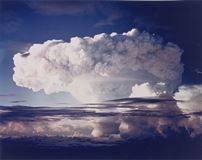Nuclear fusion

Hydrogen bomb Ivy Mike
History
The American chemist William Draper Harkins (1873 - 1951) was the first to propose the concept of nuclear fusion in 1915. In 1921, the American scientist Arthur Stanley Eddington (1882 - 1944) suggested hydrogen–helium fusion could be the primary source of stellar energy.A self-sustaining nuclear fusion was first carried out in November 1952, in the Ivy Mike hydrogen bomb test on the Enewetak Atoll in the Northwestern Pacific Ocean.